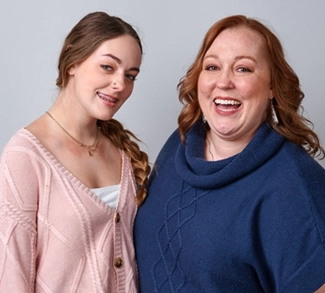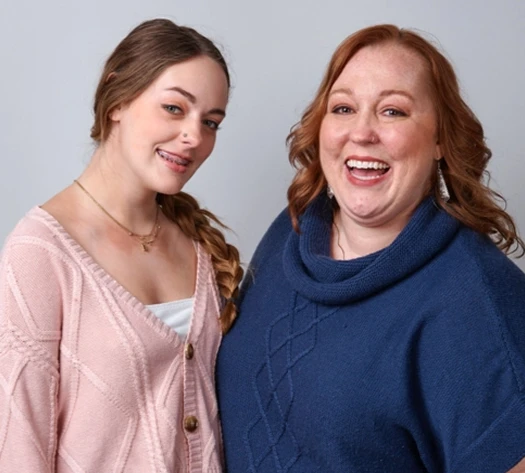DISCOVER MORE MOMENTS
Every journey with vitiligo is unique. Hear from real people living with nonsegmental vitiligo on how they found their Moment of Clarity to take back control of their condition with OPZELURA.
See their storiesMoments of Clarity shares personal stories from people living
with nonsegmental vitiligo and mild to moderate atopic dermatitis, the most
common form of eczema. Each story captures a turning point in their journey—from
recognizing the need for support, to seeking care, to experiencing meaningful
improvement* in their condition with the help of OPZELURA® (ruxolitinib) cream 1.5%.
Moments of Clarity shares personal stories from people living with nonsegmental vitiligo and mild to moderate atopic dermatitis, the most common form of eczema. Each story captures a turning point in their journey—from recognizing the need for support, to seeking care, to experiencing meaningful improvement* in their condition with the help of OPZELURA® (ruxolitinib) cream 1.5%.


Restoring lost pigment: Discover real stories from people living with nonsegmental vitiligo experiencing repigmentation.
*In a clinical study, 30% of patients achieved 75% improvement to vitiligo areas on the face at 6 months versus 13% using a non-medicated cream. Similar results were seen in another study.


Calming the flare-ups: Discover real stories from people living with mild to moderate eczema and how they found relief.
*In a clinical study of patients 2-11, 57% of patients achieved clear or almost clear skin at 8 weeks versus 11% using a non-medicated cream. In a clinical study of patients 12+, 54% achieved clear or almost clear skin with OPZELURA at 8 weeks compared to 15% using a non-medicated cream. Similar results were seen in another clinical study.
Individuals were compensated for their participation.
Vitiligo is a chronic autoimmune condition where the body’s immune system mistakenly attacks the cells that give the skin color, causing white patches to appear on the skin. The most common type of vitiligo is nonsegmental vitiligo, where these patches appear on both sides of the body. Vitiligo affects an estimated 1.9 to 2.8 million people in the United States and can have a significant impact on their lives.


Sarah
As a mom and educator living with vitiligo, Sarah wrestled with balancing her feelings about her vitiligo with being the role model she wanted to be for her daughter. Hear how Sarah found equilibrium with treatment and taking control back from her vitiligo. Results may vary.
Individuals were compensated for their participation.
Ray
After his later-in-life diagnosis, Ray applied the principles he cultivated as a professional runner to his journey navigating nonsegmental vitiligo. Learn how he stayed consistent with his vitiligo treatment and tracked his repigmentation to achieve his goals. Results may vary.
Individuals were compensated for their participation.
Sam
Sam used to spend hours in the morning using makeup to cover her loss of pigment from nonsegmental vitiligo. Listen to her new approach to time management and morning routine after repigmentation. Results may vary.
Individuals were compensated for their participation.
Rissa
When people made assumptions about the white patches on Rissa’s skin, she realized they saw her as someone with vitiligo rather than a person. She didn’t let this define her. Learn about her love of community, journey to finding a vitiligo treatment, and her hope for all people living with vitiligo. Results may vary.
Individuals were compensated for their participation.

Every journey with vitiligo is unique. Hear from real people living with nonsegmental vitiligo on how they found their Moment of Clarity to take back control of their condition with OPZELURA.
See their stories




If you are experiencing challenges getting an in-person appointment with a physician who understands vitiligo, consider starting the conversation through telehealth. Connect with a provider who has the latest information on vitiligo and management options from the comfort of your own home.
Incyte does not in any way control or influence any telemedicine healthcare provider. These healthcare providers exercise their own independent medical judgment and are under no obligation to prescribe any medication.


Atopic dermatitis (AD), the most common type of eczema, affects an estimated 2-3 million children aged 2-11 and more than 7.5 million people aged 12 and older in the United States. This chronic immune-mediated condition can lead to a cycle of itching and scratching, and each person’s experience with eczema is unique.
OPZELURA is a twice-daily cream for the treatment of mild to moderate eczema that has proven to provide clear or almost clear skin. It is a steroid-free cream that targets eczema at a key source.
In a clinical study of patients 2-11, 57% achieved clear or almost clear skin with OPZELURA at 8 weeks compared to 11% using a non-medicated cream.
In a clinical study of patients 12+, 54% achieved clear or almost clear skin with OPZELURA at 8 weeks compared to 15% using a non-medicated cream. Similar results were seen in another clinical study.
The use of OPZELURA along with therapeutic biologics, other JAK inhibitors, or strong immunosuppressants such as azathioprine or cyclosporine is not recommended.


Piper & Adam
Triggers like heat and grass caused flare-ups that affected Piper during her favorite outdoor activities. Hear how she and her dad, Adam, navigated finding the right eczema treatment while balancing life as a kid. Results may vary.
Individuals were compensated for their participation.
Anna & Rachael
Anna often experienced eczema flare-ups during the activities she loved. Her mom, Rachael, tried numerous options to help. Hear how their journey led to an eczema treatment that helped Anna find relief while staying active. Results may vary.
Individuals were compensated for their participation.
Dr. Lee
Widely known as Dr. Pimple Popper, Dr. Lee brings unique perspective to her dermatology practice as she not only treats patients, but also treats her own eczema with OPZELURA. Discover her personal experiences with eczema and how that deepened her relationships with her patients. Results may vary.
Individuals were compensated for their participation.
Emily
As Emily grew older and her eczema worsened, her family and coworkers began noticing her flare-ups. See when she realized she needed a change and how she found eczema relief. Results may vary.
Individuals were compensated for their participation.

Learn how people living with mild to moderate eczema have experienced their Moments of Clarity, sharing their unique journeys from the challenges of managing their symptoms to finding relief with the help of OPZELURA. Results may vary.
Hear their eczema stories




If you are experiencing challenges getting an in-person appointment with a physician who understands eczema, consider starting the conversation through telehealth. Connect with a provider who has the latest information on eczema and management options from the comfort of your own home.
Incyte does not in any way control or influence any telemedicine healthcare provider. These healthcare providers exercise their own independent medical judgment and are under no obligation to prescribe any medication.


Indication and Usage
OPZELURA is a prescription medicine used on the skin (topical) for:
The use of OPZELURA along with therapeutic biologics, other JAK inhibitors, or strong immunosuppressants such as azathioprine or cyclosporine is not recommended.
It is not known if OPZELURA is safe and effective in children less than 2 years of age with atopic dermatitis and less than 12 years with nonsegmental vitiligo.
Important Safety Information
OPZELURA is for use on the skin only. Do not use OPZELURA in your eyes, mouth, or vagina.
OPZELURA may cause serious side effects, including:
Serious Infections: OPZELURA contains ruxolitinib. Ruxolitinib belongs to a class of medicines called Janus kinase (JAK) inhibitors. JAK inhibitors are medicines that affect your immune system. JAK inhibitors can lower the ability of your immune system to fight infections. Some people have had serious infections while taking JAK inhibitors by mouth, including tuberculosis (TB), and infections caused by bacteria, fungi, or viruses that can spread throughout the body. Some people have been hospitalized or died from these infections. Some people have had serious infections of their lungs while taking OPZELURA. Your healthcare provider should watch you closely for signs and symptoms of TB during treatment with OPZELURA.
OPZELURA should not be used in people with an active, serious infection, including localized infections. You should not start using OPZELURA if you have any kind of infection unless your healthcare provider tells you it is okay. You may be at a higher risk of developing shingles (herpes zoster) while using OPZELURA.
Increased risk of death due to any reason (all causes): Increased risk of death has happened in people 50 years of age and older who have at least 1 heart disease (cardiovascular) risk factor and are taking a medicine in the class of medicines called JAK inhibitors by mouth.
Cancer and immune system problems: OPZELURA may increase your risk of certain cancers by changing the way your immune system works. Lymphoma and other cancers have happened in people taking a medicine in the class of medicines called JAK inhibitors by mouth. People taking JAK inhibitors by mouth have a higher risk of certain cancers including lymphoma and lung cancer, especially if they are a current or past smoker. Some people have had skin cancers while using OPZELURA. Your healthcare provider will regularly check your skin during your treatment with OPZELURA. Limit the amount of time you spend in the sunlight. Wear protective clothing when you are in the sun and use a broad-spectrum sunscreen.
Increased risk of major cardiovascular events: Increased risk of major cardiovascular events such as heart attack, stroke, or death have happened in people 50 years of age and older who have at least 1 heart disease (cardiovascular) risk factor and taking a medicine in the class of medicines called JAK inhibitors by mouth, especially in current or past smokers.
Blood clots: Blood clots in the veins of your legs (deep vein thrombosis, DVT) or lungs (pulmonary embolism, PE) can happen in some people taking OPZELURA. This may be life-threatening. Blood clots in the vein of the legs (deep vein thrombosis, DVT) and lungs (pulmonary embolism, PE) have happened more often in people who are 50 years of age and older and with at least 1 heart disease (cardiovascular) risk factor taking a medicine in the class of medicines called JAK inhibitors by mouth.
Low blood cell counts: OPZELURA may cause low platelet counts (thrombocytopenia), low red blood cell counts (anemia), and low white blood cell counts (neutropenia, lymphopenia, leukopenia). Your healthcare provider may do a blood test to check your blood cell counts during your treatment with OPZELURA and may stop your treatment if signs or symptoms of low blood cell counts happen.
Cholesterol increases: Cholesterol increase has happened in people when ruxolitinib is taken by mouth. Tell your healthcare provider if you have high cholesterol or triglycerides.
Before starting OPZELURA, tell your healthcare provider if you:
After starting OPZELURA:
Tell your healthcare provider about all the medicines you take, including prescription and over-the-counter medicines, vitamins, and herbal supplements.
The most common side effects of OPZELURA in people treated for atopic dermatitis include: common cold (nasopharyngitis), diarrhea, bronchitis, ear infection, increase in a type of white blood cell (eosinophil) count or decrease in a type of white blood cell (neutropenia) count, hives, inflamed hair pores (folliculitis), swelling of the tonsils (tonsillitis), runny nose (rhinorrhea), upper respiratory tract infection, COVID-19, fever, and pain, irritation, discomfort, or itching at the application site.
The most common side effects of OPZELURA in people treated for nonsegmental vitiligo include: acne at the application site, itching at the application site, common cold (nasopharyngitis), headache, urinary tract infection, redness at the application site, and fever.
These are not all of the possible side effects of OPZELURA. Call your doctor for medical advice about side effects. You may report side effects to FDA at 1-800-FDA-1088. You may also report side effects to Incyte Corporation at 1-855-463-3463.
Please see the Full Prescribing Information, including Boxed Warning, and Medication Guide for OPZELURA.
Indication and Usage
OPZELURA is a prescription medicine used on the skin (topical) for:
Important Safety Information
OPZELURA may cause serious side effects, including:
Serious Infections: OPZELURA contains ruxolitinib. Ruxolitinib belongs to a class of medicines called Janus kinase (JAK) inhibitors. JAK inhibitors are medicines that affect your immune system. JAK inhibitors can lower the ability of your immune system to fight infections. Some people have had serious infections while taking JAK inhibitors by mouth, including tuberculosis (TB), and infections caused by bacteria, fungi, or viruses that can spread throughout the body. Some people have been hospitalized or died from these infections. Some people have had serious infections of their lungs while taking OPZELURA. Your healthcare provider should watch you closely for signs and symptoms of TB during treatment with OPZELURA.
Important Safety Information
OPZELURA may cause serious side effects, including:
Serious Infections: OPZELURA contains ruxolitinib. Ruxolitinib belongs to a class of medicines called Janus kinase (JAK) inhibitors. JAK inhibitors are medicines that affect your immune system. JAK inhibitors can lower the ability of your immune system to fight infections.